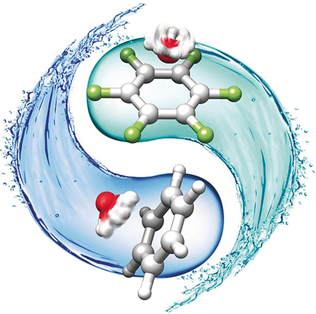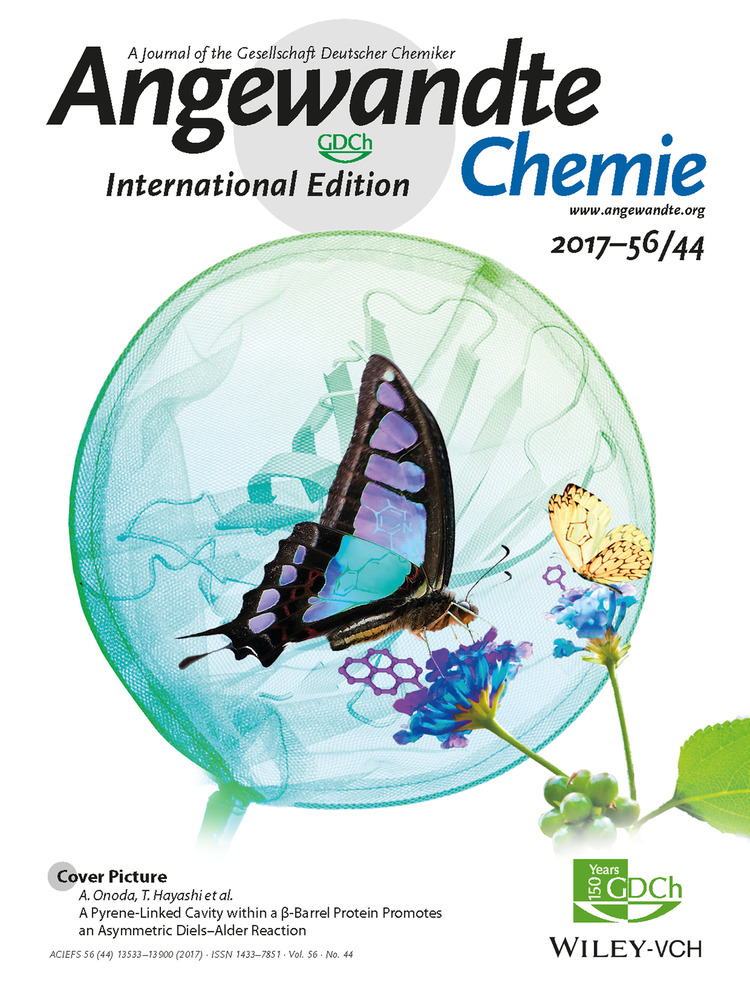Rotational Spectroscopy Probes Water Flipping by Full Fluorination of Benzene
Dr. Luca Evangelisti
Dipartimento di Chimica “G. Ciamician”, Università degli Studi di Bologna, Via Selmi 2, 40126 Bologna, Italy
Search for more papers by this authorDr. Kai Brendel
Institut für Physikalische Chemie, Christian-Albrechts-Universität zu Kiel, Max-Eyth-Strasse 1, 24118 Kiel, Germany
Search for more papers by this authorProf. Dr. Heinrich Mäder
Institut für Physikalische Chemie, Christian-Albrechts-Universität zu Kiel, Max-Eyth-Strasse 1, 24118 Kiel, Germany
Search for more papers by this authorProf. Dr. Walther Caminati
Dipartimento di Chimica “G. Ciamician”, Università degli Studi di Bologna, Via Selmi 2, 40126 Bologna, Italy
Search for more papers by this authorCorresponding Author
Prof. Dr. Sonia Melandri
Dipartimento di Chimica “G. Ciamician”, Università degli Studi di Bologna, Via Selmi 2, 40126 Bologna, Italy
Search for more papers by this authorDr. Luca Evangelisti
Dipartimento di Chimica “G. Ciamician”, Università degli Studi di Bologna, Via Selmi 2, 40126 Bologna, Italy
Search for more papers by this authorDr. Kai Brendel
Institut für Physikalische Chemie, Christian-Albrechts-Universität zu Kiel, Max-Eyth-Strasse 1, 24118 Kiel, Germany
Search for more papers by this authorProf. Dr. Heinrich Mäder
Institut für Physikalische Chemie, Christian-Albrechts-Universität zu Kiel, Max-Eyth-Strasse 1, 24118 Kiel, Germany
Search for more papers by this authorProf. Dr. Walther Caminati
Dipartimento di Chimica “G. Ciamician”, Università degli Studi di Bologna, Via Selmi 2, 40126 Bologna, Italy
Search for more papers by this authorCorresponding Author
Prof. Dr. Sonia Melandri
Dipartimento di Chimica “G. Ciamician”, Università degli Studi di Bologna, Via Selmi 2, 40126 Bologna, Italy
Search for more papers by this authorGraphical Abstract
Flipping water: The prototype system for the lone-pair⋅⋅⋅π-hole interaction, hexafluorobenzene–water, has been investigated by rotational spectroscopy. Interesting chemical and dynamic features have been found: a) fluorine substitution flips the water bond with benzene, from O−H⋅⋅⋅π to O⋅⋅⋅π hole; b) water is almost freely rotating above the ring and the spectrum of the complex appears to be that of a symmetric top.
Abstract
The topology of the interaction of water with benzene changes drastically upon full H→F substitution on the aromatic ring: the weak O−H⋅⋅⋅π hydrogen bond is replaced by a O⋅⋅⋅π linkage, of about the same strength. Hexafluorobenzene–water appears to be the prototype system to investigate this kind of weak bond. The pulsed Fourier transform microwave technique has been used for the detection of the rotational spectra of the normal species and five isotopologues which unambiguously led to the identification of the geometry. Quantum mechanical calculations have been performed to interpret the experimental evidence.
Supporting Information
As a service to our authors and readers, this journal provides supporting information supplied by the authors. Such materials are peer reviewed and may be re-organized for online delivery, but are not copy-edited or typeset. Technical support issues arising from supporting information (other than missing files) should be addressed to the authors.
| Filename | Description |
|---|---|
| anie201707155-sup-0001-misc_information.pdf486.4 KB | Supplementary |
Please note: The publisher is not responsible for the content or functionality of any supporting information supplied by the authors. Any queries (other than missing content) should be directed to the corresponding author for the article.
References
- 1See, for example,
- 1aM. Cametti, B. Crousse, P. Metrangolo, R. Milani, G. Resnati, Chem. Soc. Rev. 2012, 41, 31–42;
- 1bR. Berger, G. Resnati, P. Metrangolo, E. Weber, J. Hulliger, Chem. Soc. Rev. 2011, 40, 3496–3508.
- 2
- 2aS. Suzuki, P. G. Green, R. E. Bumgarner, S. Dasgupta, W. A. Goddard, G. A. Blake, Science 1992, 257, 942–945;
- 2bE. Arunan, H. S. Gutowsky, J. Chem. Phys. 1993, 98, 4294–4296;
- 2cH. S. Gutowsky, T. Emilson, E. Arunan, J. Chem. Phys. 1993, 99, 4883–4893;
- 2dE. Arunan, T. Emilsson, H. S. Gutowsky, J. Chem. Phys. 1994, 101, 861–868.
- 3K. Brendel, H. Mäder, Y. Xu, W. Jäger, J. Mol. Spectrosc. 2011, 268, 47–52.
- 4
- 4aS. Melandri, L. Evangelisti, A. Maris, W. Caminati, B. M. Giuliano, V. Feyer, K. C. Prince, M. Coreno, J. Am. Chem. Soc. 2010, 132, 10269–10271;
- 4bB. M. Giuliano, V. Feyer, K. C. Prince, M. L. Evangelisti, S. Melandri, W. Caminati, J. Phys. Chem. A 2010, 114, 12725–12730;
- 4cS. Melandri. B. M. Giuliano, A. Maris, L. B. Favero, P. Ottaviani, B. Velino, W. Caminati, J. Phys. Chem. A 2007, 111, 9076–9079.
- 5
- 5aB. M. Giuliano, S. Melandri, A. Maris, L. B. Favero, W. Caminati, Angew. Chem. Int. Ed. 2009, 48, 1102–1105; Angew. Chem. 2009, 121, 1122–1125;
- 5bS. Melandri, A. Maris, B. M. Giuliano, L. B. Favero, W. Caminati, Phys. Chem. Chem. Phys. 2010, 12, 10210–10214.
- 6Q. Gou, G. Feng, L. Evangelisti, W. Caminati, Angew. Chem. Int. Ed. 2013, 52, 11888–11891; Angew. Chem. 2013, 125, 12104–12107.
- 7C. Calabrese, Q. Gou, A. Maris, W. Caminati, S. Melandri, J. Phys. Chem. Lett. 2016, 7, 1513–1517.
- 8G. T. Fraser, F. J. Lovas, R. D. Suenram, D. D. Nelson, W. Klemperer, J. Chem. Phys. 1986, 84, 5983–5988.
- 9
- 9aH. M. Pickett, J. Mol. Spectrosc. 1991, 148, 371–377;
- 9bJ. K. G. Watson in Vibrational Spectra and Structure, Vol. 6 (Ed.: ), Elsevier, New York, 1977, pp. 1–89.
- 10
- 10aJ. Kraitchman, Am. J. Phys. 1953, 21, 17–24;
- 10bW. Gordy, R. L. Cook, Microwave Molecular Spectra, Wiley, New York, 1984.
- 11L. Evangelisti, C. Perez, N. A. Seifert, B. H. Pate, M. Dehghany, N. Moazzen-Ahmadi, A. R. W. McKellar, J. Chem. Phys. 2015, 142, 104309.
- 12C. Pérez, A. L. Steber, A. M. Rijs, B. Temelso, G. C. Shields, J. C. Lopez, Z. Kisiel, M. Schnell, Phys. Chem. Chem. Phys. 2017, 19, 14214–14223.
- 13Gaussian 09 (Revision D.01) M. J. Frisch et al. See Supporting Information for the full reference.
- 14Y. Danten, T. Tassaing, M. Besnard, J. Phys. Chem. A 1999, 103, 3530–3534.
- 15
- 15aE. R. Johnson, S. Keinan, P. Mori-Sanchez, J. Contreras-Garcia, A. J. Cohen, W. Yang, J. Am. Chem. Soc. 2010, 132, 6498–6506;
- 15bT. Lu, F. Chen, J. Comput. Chem. 2012, 33, 580–592.
- 16
- 16aB. Jeziorski, R. Moszynski, K. Szalewicz, Chem. Rev. 1994, 94, 1887–1930;
- 16bR. M. Parrish, et al., J. Chem. Theory. Comput. 2017, 13, 3185–3197; See Supporting Information for the full reference.
- 17
- 17aW. Caminati, S. Melandri, I. Rossi, P. G. Favero, J. Am. Chem. Soc. 1999, 121, 10098–10101;
- 17bW. Caminati, S. Melandri, M. Schnell, D. Banser, J. U. Grabow, J. L. Alonso, J. Mol. Struct. 2005, 742, 87–90.
- 18
- 18aK. Reichenbächer, H. I. Süss, J. Hulliger, Chem. Soc. Rev. 2005, 34, 22–30;
- 18bL. M. Salonen, M. Ellermann, F. Diederich, Angew. Chem. Int. Ed. 2011, 50, 4808–4842; Angew. Chem. 2011, 123, 4908–4944.
- 19
- 19aP. Politzer, J. S. Murray, T. Clark, Phys. Chem. Chem. Phys. 2010, 12, 7748–7757;
- 19bJ. S. Murray, P. Lane, T. Clark, K. E. Riley, P. Politzer, J. Mol. Model. 2012, 18, 541–548.
- 20A. Bauzá, T. J. Mooibroek, A. Frontera, ChemPhysChem 2015, 16, 2496–2517.
- 21
- 21aU. Andresen, H. Dreizler, J.-U. Grabow, Rev. Sci. Instrum. 1990, 61, 3694–3699;
- 21bU. Andresen, H. Dreizler, U. Kretschmer, W. Stahl, C. Thomsen, Fresenius J. Anal. Chem. 1994, 349, 272–276;
- 21cW. Caminati, L. Evangelisti, G. Feng, B. M. Giuliano, Q. Gou, S. Melandri, J.-U. Grabow, Phys. Chem. Chem. Phys. 2016, 18, 17851–17855.





